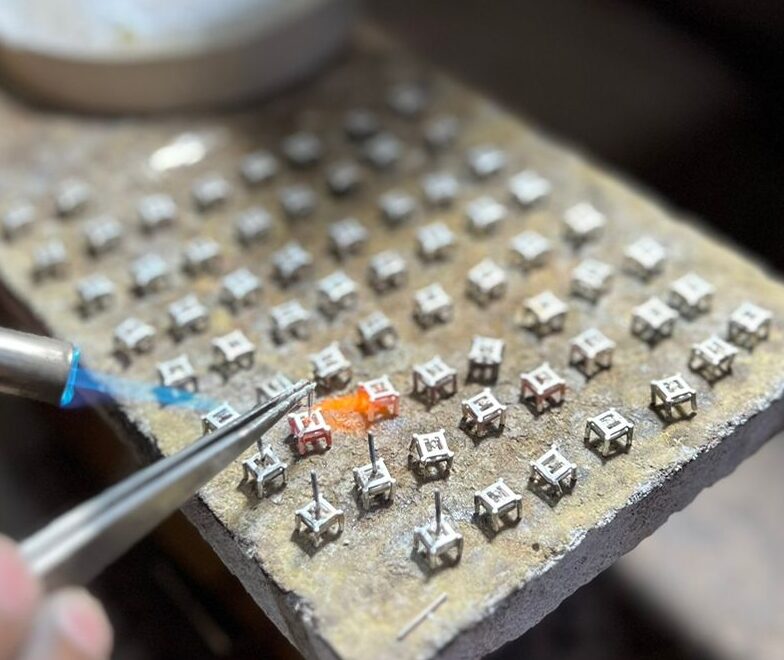
Introduction
- What is 925 Sterling Silver Jewelry?
925 sterling silver jewelry is crafted from 92.5% pure silver mixed with 7.5% other metals, often copper. This combination makes the silver stronger and more durable, perfect for jewelry that can handle everyday wear without losing its shine. - Why Authenticity Matters
Authentic sterling silver is not just beautiful—it holds its value and charm over time. Look for the hallmark “925,” a trusted guarantee that the piece meets the standard silver content, so you know you’re getting genuine quality. (1)
Understanding 925 Sterling Silver
- Composition of 925 Sterling Silver
925 sterling silver is made from 92.5% pure silver mixed with 7.5% other metals, typically copper. This blend not only increases its hardness but also reduces tarnishing, making it ideal for crafting detailed and intricate jewelry designs. - How It Differs from Other Types of Silver
Pure silver, also known as fine silver, is 99.9% pure but far too soft for everyday wear. Sterling silver solves this problem by combining beauty with durability, creating jewelry that’s strong enough for regular use while still maintaining its shine. - Common Uses of Sterling Silver Jewelry
Sterling silver is a favorite choice for rings, bracelets, earrings, and necklaces. Its striking appearance and long-lasting durability make it a go-to material for creating stunning, timeless pieces. (2)
Reasons to Buy Authentic Sterling Silver
- Long-lasting Value and Durability
Authentic sterling silver jewelry is built to last a lifetime with proper care. Its durable composition makes it resistant to scratches and dents, offering better quality than cheaper alternatives. - Aesthetic Appeal and Timeless Design
The radiant luster of sterling silver enhances both classic and modern jewelry designs, making it a versatile and enduring choice for all styles. - Resale Value and Investment Potential
Sterling silver’s value is tied to the market price of silver, which, as of May 2024, is approximately $27 per ounce. This intrinsic value ensures your jewelry is not just a fashion accessory but also a smart investment.
How to Spot Authentic 925 Sterling Silver
- Identifying Hallmarks and Stamps
Look for clear markings like “.925,” “Sterling,” or “Ster” on the jewelry. These stamps confirm that the piece meets the sterling silver standard. - Testing with a Magnet
Real sterling silver isn’t magnetic. If a piece is drawn to a magnet, it likely contains other metals or is counterfeit. - Acid Testing for Silver Purity
A jeweler can use an acid test to verify the metal’s purity. This involves applying a special acid that reacts uniquely with different metals, confirming the presence of genuine sterling silver.
Visual Indicators of Authenticity
- Inspecting the Shine and Luster
Authentic sterling silver has a distinct, bright sheen that doesn’t fade quickly, unlike lower-quality materials. - Scratches and Patina as Signs of Authenticity
Over time, genuine sterling silver develops a natural patina that adds a vintage charm to the piece, while fake items tend to wear unevenly.
Fake Sterling Silver: Common Tricks
- Misleading Stamps and Markings
Counterfeit jewelry may display fake or incorrect hallmarks. Always verify authenticity with reputable sources or professional jewelers before making a purchase.
Professional Methods to Verify Authenticity
- X-Ray Fluorescence (XRF) Analysis
This advanced, non-destructive testing technique accurately identifies the metal composition without harming the jewelry. - Consulting Certified Jewelers
Experienced jewelers have the tools and expertise to authenticate sterling silver, providing you with reliable assessments.
Care and Maintenance of Sterling Silver Jewelry
- Preventing Tarnish
Store your sterling silver pieces in anti-tarnish pouches or cloths to protect them from exposure to moisture and air, which can cause tarnishing. - Cleaning Methods for Sterling Silver
Gently clean sterling silver with mild soap and water or use specialized silver cleaners to maintain its shine and prevent damage.
Benefits of Knowing How to Identify Real Sterling Silver
Understanding how to verify sterling silver ensures you can avoid scams, make informed purchases, and select high-quality jewelry that lasts a lifetime.
Common Misconceptions About Sterling Silver
- Sterling Silver is the Same as Pure Silver
Pure silver is 99.9% silver, but it’s too soft for most uses. Sterling silver adds other metals to enhance strength and usability. - Tarnish Indicates Fake Silver
Tarnishing is a natural process for sterling silver. With proper care, the original shine can be restored. - Authentic Sterling Silver is Extremely Expensive
While high-quality pieces are an investment, affordable options exist that don’t compromise on authenticity.
Where to Buy Authentic Sterling Silver Jewelry
You can find authentic sterling silver jewelry on trustworthy online platforms or at reputable physical stores, which often provide guarantees of authenticity and quality. Looking for genuine 925 sterling silver pieces? Check out our 925 Sterling Silver Ring Collection.
The Role of Government Standards and Regulations
Government regulations ensure that precious metals like sterling silver are correctly marked and meet quality standards, protecting consumers from fraud and guaranteeing authenticity in products like jewelry.
FAQs About 925 Sterling Silver
1. How to know if 925 silver is real?
To verify if 925 silver is real, look for:
- A “925” stamp indicating 92.5% silver content.
- Perform an acid test using a silver testing kit, where a drop of acid will turn a certain color if it’s real silver.
- Use a magnet—real silver is non-magnetic.
- Check the item for tarnishing—sterling silver will develop a patina over time.
2. Can fake sterling silver have a 925 stamp?
Yes, fake sterling silver items can be falsely stamped with “925.” Always verify authenticity through additional tests like the acid test or magnet test, as the stamp alone is not a guarantee.
3. Is 925 sterling silver hallmarked?
Yes, genuine sterling silver is often hallmarked with a “925” stamp. In some countries, additional hallmarks (like the maker’s mark or assay office symbol) may also be present, depending on local regulations.
4. How to test sterling silver at home?
- Magnet Test: Sterling silver is not magnetic, so it should not stick to a magnet.
- Ice Test: Real silver conducts heat efficiently. Place an ice cube on the silver piece; it should melt quickly.
- Tarnish Test: Rub the item with a soft white cloth. If black marks appear, it could be tarnished sterling silver.
- Acid Test: Use a silver testing kit for an accurate result.
5. How much is 925 silver worth today?
The value of 925 silver depends on the current spot price of silver in the market, which fluctuates daily. Since 925 silver contains 92.5% pure silver, multiply the silver weight by 0.925 and the current price per gram/ounce of silver.
6. Does 925 silver always have a stamp?
Not always. While reputable jewelers and manufacturers typically stamp 925 silver, older or handmade pieces might lack a stamp. In such cases, professional testing can confirm authenticity.
7. Will a magnet stick to 925 silver?
No, genuine 925 sterling silver is not magnetic. If a magnet sticks to the item, it likely contains other metals or is not real silver.
8. What’s the difference between 925 sterling silver and real silver?
- 925 Sterling Silver: Composed of 92.5% pure silver and 7.5% other metals (usually copper) for durability.
- Real (Pure) Silver: 99.9% silver, softer, and less durable than sterling silver, making it unsuitable for jewelry or functional items.
Sterling silver balances purity with strength, making it more practical for everyday use.
Citations:
1.https://en.wikipedia.org/wiki/Sterling_silver 2.https://jewelryinformer.com/silver/sterling-silver/

Leave a Reply